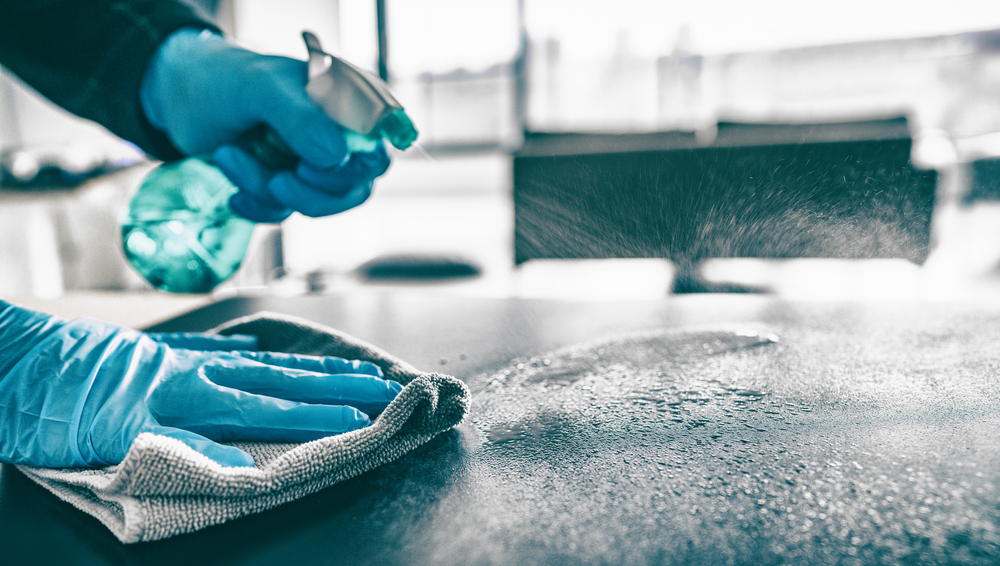By this time, most everyone knows the basics of keeping their gyms and health clubs COVID-19 clean. Since we’ve figured out the basics, now is good time to consider the chemicals, techniques and emerging technologies that may make the difference in keeping your gym healthy and safe.
Disinfectants
When choosing cleaning products for your gym, consider that every product approved against SARS-CoV-2 (COVID-19) includes an EPA registration number on its label. Although the CDC tracks coronavirus cases, it is the EPA which regulates chemicals and is the go-to source for correct cleaning information.
Does that chemical work?

To determine if that EPA registration number lists coronavirus as a target pathogen, search the regularly updated EPA.gov website for approved products. The listings provide:
- the EPA registration number
- active ingredient
- product name and company,
- contact time required to kill the virus.
- For example, a bottle of Clorox Clean Up Cleaner + Bleach contains active ingredient sodium hypochlorite, EPA registration number 5813-21, and is on the list of products for use against SARS-CoV-2 with a contact time of one minute.
This contact time, also known as “dwell time”, is the number of minutes a product needs to kill the virus. Many products have a dwell time of 5-10 minutes, requiring your employee to spray, wait, and then wipe, or else you may be just wasting time and money.
Secondly, if commercial cleaning supplies are not available, alternatives include 1/3 cup bleach per gallon of water or a 70% alcohol solution.
Current cleaning technologies
An electrostatic sprayer is one of the more exciting technologies in use today. The application process uses a sprayer in which liquid disinfectant is electrostatically charged as it passes through the nozzle, creating positively or negatively charged particles that repel one another and seek out surfaces on which to cling, effectively “wrapping itself” around the object.
The theory is the cleaning solution will reach hard-to-locate, easy-to-ignore areas and stick to them longer. Yet, its efficacy has been questioned as a whiz-bang idea that may or may not work. This month, an NIH-published study confirmed the use of an electrostatic sprayer “provided rapid and effective decontamination” and eliminated the benign virus bacteriophage MS2 from contaminated surfaces. The study looked at decontamination of portable devices, including wheelchairs, and large open areas such as waiting rooms, and found electrostatic spraying reduced contamination despite minimal pre-cleaning of the surface areas. Although this study has its drawbacks, primarily that the electrostatic spray was not used against a viral pathogen, the overwhelming conclusion is it reduced contamination. And since manual cleaning tends to miss awkward angles and surfaces, a charged spraying pattern minimizes overlooked, but possibly contaminated, surfaces.
The EPA is currently reviewing products that can be applied using the electrostatic method.
Upgrade those filters.
Your air conditioning system itself will not protect people from the virus that causes COVID-19. However, you can increase the quality of your air ventilation and filtration. Both the CDC and EPA recommend commercial building owners use portable air cleaners to supplement their HVAC system as well as utilize the highest grade compatible air filter. In addition, it is recommended direct air flow so droplets are not blown from one person to another.
On the horizon
In the near future, disinfectant formulations may include metallic nano-particles, such as silver, copper, or titanium dioxide, whose long-lasting, antiviral properties and effectiveness at lower dosages make them more appealing as long-term defenses against future viral pathogens. These same nano-materials may be built into respiratory masks to further inhibit virus transmission.
On the fast track is a Cornell-created antimicrobial coating that binds with chlorine to extend a disinfectant’s life by days and even weeks. Currently licensed as HaloFilm through Cornell, the product’s researchers recently received a National Science Foundation award to expedite its use in commercial cleaning. Users would simply spray the HaloFilm on a surface and then add the chlorine disinfectant. The coating “recharges” the chlorine molecules repeatedly over up to a month’s time, eliminating having to re-clean surfaces repeatedly throughout the day.
A Danish company ACT.Global promotes a transparent coating that allows surfaces to self-clean. The spray breaks down microbes when illuminated with normal indoor light, and can work for up to a year in a well-lit environment.
Most scientists believe such nasty pathogens as SARS, COVID-19 and others may become a staple of modern life. With that in mind, it’s always a good idea to look to the future for the best and brightest ideas to keep your business clean and customers safe.
https://www.ncbi.nlm.nih.gov/pmc/articles/PMC7275188/
https://www.nature.com/articles/s41565-020-0751-0
https://www.epa.gov/coronavirus/air-cleaners-hvac-filters-and-coronavirus-covid-19
https://news.cornell.edu/stories/2020/05/nsf-funded-antimicrobial-technology-targets-covid-19
